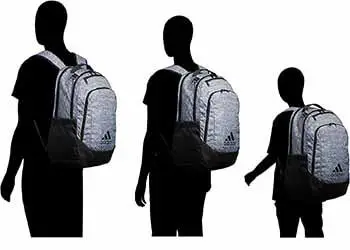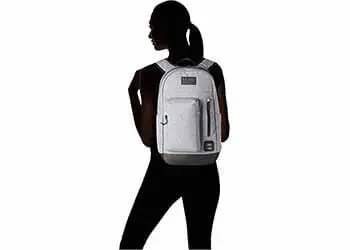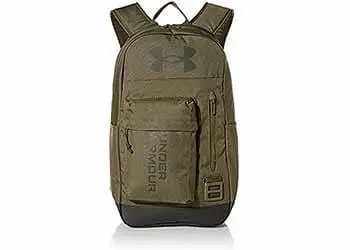The number of books that can fit into an empty backpack would depend on several factors such as the size of the backpack, the size of the books, and how tightly the books are packed. A larger backpack could hold more books than a smaller one, and smaller books could be packed more tightly than larger books. Additionally, it’s worth noting that packing a backpack too full can put strain on the straps and zippers and make it difficult to carry comfortably. So, how many books can you put in an empty backpack? Let’s now find its answer.
Kinds of Backpacks

Backpacks can be categorized into different types according to their capacity, and here are some of the most common types:
Daypacks: Typically used for short trips or hikes, daypacks are small backpacks with a capacity of 20-35 liters.
Overnight packs: These backpacks are designed for overnight trips and have a capacity of 35-50 liters.
Multi-day packs: These backpacks are designed for multi-day trips and can hold 50-70 liters of gear.
Expedition packs: These are large backpacks designed for long expeditions and can hold up to 90 liters of gear.
In terms of dimensions, backpacks can vary widely depending on the brand and model. It’s always a good idea to check the product specifications for the backpack you’re interested in to determine its size and capacity.
It’s essential to choose a backpack that’s appropriate for your needs, as carrying a backpack that’s too small or too big can be uncomfortable and may cause injury.
How Many Books Can You Put In an Empty Backpack
The number of books that can fit in an empty backpack depends on many factors including the size of the backpack, the size of the books, and the way the books are arranged in the backpack.
Assuming an average-sized backpack and average-sized books, a backpack can typically hold anywhere from 5-10 books. However, if the books are larger, heavier, or have irregular shapes, the number of books that can fit may be significantly less. On the other hand, if the books are smaller or thinner, more books can be packed into the backpack.
It’s important to note that overloading a backpack with too many books can make it difficult to carry and may cause strain on the back and shoulders. It’s recommended to consider the weight and distribution of the books when packing a backpack to avoid any potential injury.
What Can Be Put In An Empty Bag?

An empty bag can be filled with a wide variety of objects, depending on its size and purpose. Here are some examples of what can be put in an empty bag:
Clothes: You can use an empty bag to pack clothes for travel or to store off-season garments.
Books: An empty bag can be used to carry books or other reading materials.
Groceries: If you have an eco-friendly bag, you can use it to carry groceries from the store.
Toys: An empty bag can be used to store toys or as a makeshift toy bag for children.
Personal items: You can use an empty bag to store personal items such as makeup, toiletries, and other small items.
Sports equipment: An empty bag can be used to carry sports equipment such as balls, bats, or helmets.
Food: If you have a lunch bag or a cooler, you can use it to carry food and drinks.
Office supplies: An empty bag can be used to carry office supplies, such as files, folders, and papers.
Tools: You can use an empty bag to store tools or as a tool bag for easy transport.
Electronics: An empty bag can be used to store or transport electronics, such as laptops, tablets, or cameras.
You can use your backpack for many and multiple purposes. This is not only used for keeping books. Small kids use kindergarten backpacks.
What Kinds of Books Can Be Put In an Empty Backpack?
There are many kinds of books that can be put in an empty backpack, depending on the interests and preferences of the person carrying the backpack. Here are a few examples:
Fiction books: Novels, short story collections, and other works of fiction are great choices for backpacks. They can provide entertainment and escapism while on the go.
Non-fiction books: Biographies, memoirs, history books, and other works of non-fiction can be great choices for people who want to learn something new while on the go.
Reference books: Dictionaries, encyclopedias, and other reference books can be useful to have on hand when needing to look up a definition or fact.
Textbooks: Students or those studying a particular subject may need to carry textbooks with them to study or reference materials for their coursework.
Travel guides: People who are traveling may want to carry a travel guide or two to help them navigate new places and discover new things to do.
Art and photography books: These books can be great for artists or anyone who enjoys looking at beautiful images.
Children’s books: Parents or caregivers may want to carry children’s books in their backpacks to entertain their little ones while on the go.
Ultimately, the types of books that can be put in an empty backpack depend on the individual’s interests and needs.
How Many Books Can A Large Empty Backpack Hold?

The number of books that a large empty backpack can hold will depend on several factors, such as the size and weight of the books, the capacity of the backpack, and the distribution of weight within the backpack.
Assuming a typical large backpack with a capacity of around 30-40 liters and an average book size of 9 x 6 inches and a weight of 1-2 pounds, a backpack can hold approximately 10-15 books. However, if the books are larger and heavier or the backpack has a larger capacity, then it could hold more books. On the other hand, if the backpack is poorly designed or overloaded, it could cause discomfort or injury to the person carrying it.
It’s important to note that the number of books a backpack can hold safely will also depend on the physical capabilities of the person carrying it, as well as the distance and duration of the journey. It’s always a good idea to distribute the weight evenly and take breaks as needed to avoid strain or injury.
Final Words
In conclusion, the number of books that can fit in an empty backpack depends on several factors such as the size and weight of the backpack, the size and weight of the books, and the backpack’s design and material. However, it is possible to estimate the number of books that can fit in an empty backpack based on these factors.
Besides, it is important to note that overloading a backpack with too many books can cause physical strain and discomfort, and potentially lead to long-term back problems. Therefore, it is advisable to consider the weight and size of the books and to distribute them evenly in the backpack to avoid strain on one particular area. Ultimately, it is best to find a backpack that suits your needs and is designed to carry the amount and type of books that you typically carry.
Read More Articles:
- Largest Luggage Size For Check-In
- How To Protect Luggage From Theft
- How To Clean Fabric Luggage
- Can You Wash A North Face Backpack
- How To Wash North Face Backpack

